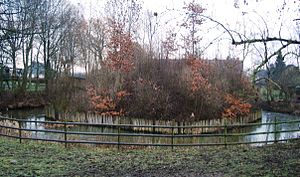Havekost tower hill castle
| Havekost tower hill castle | ||
|---|---|---|
|
The remains of the castle in Havekost - the castle hill surrounded by palisades in the (restored) moat |
||
| Alternative name (s): | Havekoster Castle | |
| Creation time : | around 1200 | |
| Castle type : | Niederungsburg, moth | |
| Conservation status: | Castle hill, moat, palisade | |
| Standing position : | Nobles | |
| Place: | Ahrensbök -Havekost | |
| Geographical location | 54 ° 1 '6.6 " N , 10 ° 37' 12" E | |
|
|
||
The tower hill castle Havekost , also called Havekoster castle , is the remainder of a medieval tower hill castle (Motte) in the village Havekost in the municipality Ahrensbök in the Ostholstein district in Schleswig-Holstein .
The overgrown castle hill / tower hill surrounded by the ring moat and the palisades is - not directly accessible - in the middle of a meadow, a few meters from the road in the middle of the village of Havekost. It is one of the best preserved fortifications of this type in Ostholstein .
description
The castle complex was originally a hill tower castle (Motte) surrounded by an 8 to 10 meter wide moat . On the steeply rising castle hill of approx. 5 meters height there was a (presumably) made of wood tower ( keep ) which was protected by a square row of palisades at the moat . Access to the castle was provided by a spanning the moat bridge on the northern side and carried via the associated - also protected by a moat - farmyard .
history
- The castle was built after Wagriens had been conquered - probably in the 12th century.
- In the 14th century it was u. a. owned by the knightly families Swin and Lasbeke .
- Havekost (and with it the castle) came in 1386 as a gift from Count Adolf VII (Holstein-Kiel) (1359-1390) to the knight Jakob Crumbeke - who bequeathed Havekost to the church in Ahrensbök in 1387 , making it part of the lands of the Ahrensbök Monastery .
- The castle was probably abandoned in the 15th century - after that it fell into disrepair, the moat silted up / was filled in and was forgotten.
- It was only after the Second World War that the owner of the farm - on which the remains of the castle are located - recognized the importance of the castle and initiated steps towards protection and restoration.
- In 1975 the remains of the castle were placed under monument protection.
- In 1980 an archaeological investigation of the castle was carried out, which made a reconstruction possible based on the remains of the posts found. The finds made in the ditch from the 14th and 15th centuries included numerous iron bolts , which suggest that a siege had taken place.
As part of the / after the archaeological investigations, the moat - with a width of nine meters and a depth of one meter - was re-dug and the castle hill including the palisades was restored. The intention to rebuild the wooden tower was not implemented.


